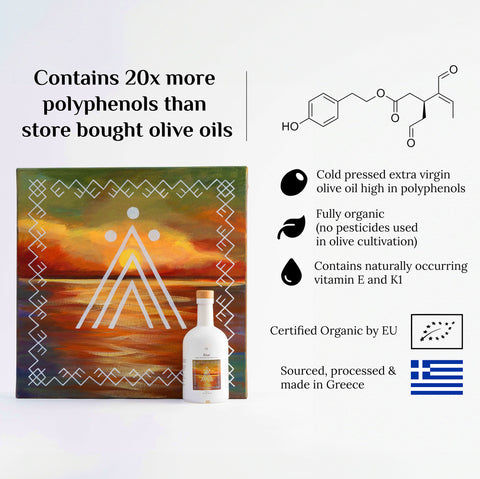Polyphenols are a group of naturally occurring compounds found in plants, including olive oil, that have potent antioxidant and anti-inflammatory properties. They play a critical role in protecting your cells from oxidative stress, which is linked to a variety of chronic diseases such as heart disease, cancer, and neurodegenerative conditions like Alzheimer's.
Research shows that polyphenols can:
- Improve heart health by lowering blood pressure and reducing cholesterol levels
- Fight inflammation
- Protect the body against oxidative damage
- Enhance brain function
- Lower the risk of certain cancers
Factors That Determine Polyphenol Levels in Olive Oil
The polyphenol content in olive oil can vary widely based on several key factors. Here’s what influences whether an olive oil is rich in polyphenols:
1. Olive Variety

Some olive varieties are naturally higher in polyphenols than others. Varieties such as Koroneiki (native to Greece) and Picual (from Spain) are known for their high polyphenol content. These olives produce oils that are particularly rich in antioxidants, making them a superior choice for health-conscious consumers.
Research
According to a study in Antioxidants (Basel), Koroneiki olives consistently show higher levels of polyphenols than other varieties (source).
2. Harvest Time
The timing of the olive harvest has a significant impact on polyphenol levels. Olives harvested early, when they are still green, tend to have a higher concentration of polyphenols compared to those harvested later when the fruit has fully ripened.
Research
A 2020 study in the Biochemical Genetics found that early-harvest olives had a significantly higher concentration of polyphenols compared to late-harvest olives (source).
3. Climate and Soil Conditions
The growing conditions, such as climate, soil quality, and altitude, also influence the polyphenol content in olive oil. Olives grown in regions with more intense sunlight and less rainfall tend to produce oils with higher polyphenol levels. Greece, in particular, has optimal conditions for producing polyphenol-rich olive oils due to its sunny Mediterranean climate.
Research
A 2018 study published in ACS Omega revealed that olives grown in drier, sunnier climates showed increased polyphenol concentration compared to those grown in wetter regions (source).
4. Processing Method
The way olive oil is processed also affects its polyphenol content. Cold-pressing olives at low temperatures helps preserve their natural polyphenols. Extra virgin olive oil (EVOO) is produced using this method and is typically the highest in polyphenols. In contrast, refined oils, which are subjected to heat and chemicals, lose many of their beneficial compounds during processing.
Research
A 1996 study in the Asia Pacific Journal of Clinical Nutrition concluded that cold-pressed extra virgin olive oil retains up to 80% more polyphenols than refined olive oils (source).
5. Storage Conditions
Even after olive oil is produced, its polyphenol content can degrade over time if not stored properly. Exposure to light, heat, and air can cause the antioxidants in olive oil to break down. For this reason, it’s crucial to store olive oil in a cool, dark place in a tightly sealed, dark glass bottle.
Research
A study in Food Chemistry found that olive oil stored in dark glass bottles retained more polyphenols over time compared to oil stored in clear plastic containers (source).
How to Choose Olive Oil High in Polyphenols
Now that we know what affects the polyphenol content

- Look for Extra Virgin Olive Oil (EVOO): Choose cold-pressed EVOO, as it retains the most polyphenols.
- Check for Early Harvest on the Label: Look for olive oils labeled as “early harvest,” indicating the olives were picked while still green and polyphenol-rich.
-
Opt for Specific Olive Varieties: Greek olive oils m
ade from the Koroneiki variety or Spanish oils from Picual olives are often higher in polyphenols. - Pay Attention to Packaging: Select olive oil that comes in dark, glass bottles to protect the oil from light and oxidation.
- Consider Origin: Olive oil from regions like Greece, Spain, and Italy, where growing conditions are optimal, often has higher polyphenol content. For example, our own olive oil Rise™ is sourced from the historical region of Arcadia, Greece and offers exceptionally high polyphenol content of over 1200mg/kg.
Conclusion
Not all olive oils are the same when it comes to health benefits. If you're looking for an olive oil high in polyphenols, choose extra virgin varieties from early-harvest olives, preferably from regions with ideal growing conditions such as Greece. These oils offer higher concentrations of antioxidants, providing more robust protection against inflammation, heart disease, and other chronic conditions.
By selecting olive oils rich in polyphenols, you can enjoy both exceptional flavor and impressive health benefits.








